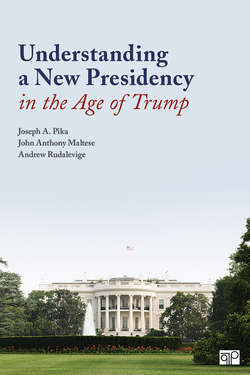Читать книгу Understanding a New Presidency in the Age of Trump - Joseph A. Pika - Страница 12
The Administrative Presidency
ОглавлениеPresidents are not limited to taking action exclusively by working through Congress. From the first days of his administration, President Trump embraced a unilateral exercise of executive power through the use of executive orders and other administrative directives, many of which he dramatically unveiled at televised signing ceremonies. Six days after taking office, Trump issued an executive order that directed the Department of Homeland Security to begin immediate construction of a 1,900-mile wall along the border with Mexico and to assign an additional 5,000 border protection agents to the area. Doing so, Trump declared “We do not need new laws.”84 But despite the power of some executive orders to achieve significant results, laws are, in fact, needed to accomplish many goals, such as appropriating funds to build a wall—which a Department of Homeland Security internal report said could cost $21.6 billion—or to hire additional border patrol forces.85
Executive orders must also be able to survive legal challenges, as Trump discovered when courts struck down his early order to ban travel from a series of predominantly Muslim countries and his plan to punish “sanctuary cities” for not enforcing federal immigration laws. In response, Trump repeatedly lashed out at the judicial branch. In February, he dismissed the “so-called judge” who temporarily blocked enforcement of the travel ban and called the decision “ridiculous.” Later, when a federal judge blocked a revised version of the travel ban, Trump called the ruling “terrible.” In April, he similarly denounced a federal judge who struck down his plan to punish sanctuary cities, calling the ruling “one more example of egregious overreach by a single, unelected district judge” and claiming that the “erroneous ruling” was “a gift to the criminal gang and cartel element in our country, empowering the worst kind of human trafficking and sex trafficking, and putting thousands of innocent lives at risk.”86
Photo 6 President Trump holds aloft an executive order at a signing ceremony on January 28, 2017—one of over thirty such orders issued in his first hundred days.
Pete Marovich – Pool/Getty Images
The travel ban saga extended well beyond the ninety-day delay that the administration had originally sought. After two circuit courts also blocked the order, the Supreme Court agreed in June 2017 to take up the merits of the case in its fall term. In the meantime, the Court allowed parts of the ban to go into effect, while exempting those travelers with “formal, documented” business connections or “a credible claim of a bona fide relationship with a person or entity in the United States.”87 The government quickly held that such a relationship might include parents but not grandparents, prompting yet more lawsuits over the precise scope of the exemptions.
By the end of his first hundred days, Trump had issued over thirty executive orders (plus numerous presidential memoranda to department heads issuing similar sorts of directions).88 That amounted to a faster pace than any new president since 1945, when Harry Truman assumed the presidency after Franklin Roosevelt’s death and issued fifty-seven such orders. By comparison, in their first hundred days in office, Barack Obama issued nineteen executive orders; George W. Bush, eleven; and Bill Clinton, thirteen.
Presidents frequently use executive orders (EOs) to implement provisions of new laws. Since more laws are passed during periods when one party controls both the presidency and Congress, the number of EOs generally rises then as well. The Trump EOs, however, substituted for legislation rather than supplementing it—an approach far more common during periods of divided government, such as Obama’s last six years in office, as opposed to the period of unified government that prevailed in 2017. President Trump employed executive actions in at least eight of the ten policy areas in which he had pledged to send bills to Congress. These orders served as placeholders on complicated questions of infrastructure and energy, community safety, national security, immigration, ethics, tariffs, education and health care. Some of the directives had an immediate impact, such as urging far more aggressive deportations of individuals illegally resident in the United States; others had important but symbolic resonance, as in the formal removal of the United States from the Trans-Pacific Partnership trade pact (which had not yet even come into existence).
Beyond Congress and the courts, Trump also needed executive branch cooperation to implement his orders, since many of them directed departments to review laws and regulations with an eye towards proposing revisions to existing policy or agency organization. For example, his February 9 EO declared that “it shall be the policy of the executive branch to reduce crime in America” and demanded that the attorney general report at least once a year on ways to improve government efforts in that regard. An April 25 order replaced the Rural Council created in 2011 with a twenty-plus person task force with a 180-day deadline for recommendations aimed at “promoting agriculture and rural prosperity in America.” Other directives setting similar deadlines—such as identifying tax burdens, reviewing environmental rules, reorganizing government departments, and setting regulatory budgets—were scheduled to come due throughout Trump’s first year in office. Here too, though, the slow pace of sub-Cabinet appointments meant that fewer resources were available to conduct and monitor the many studies the various directives put in motion. A study by The Intercept
